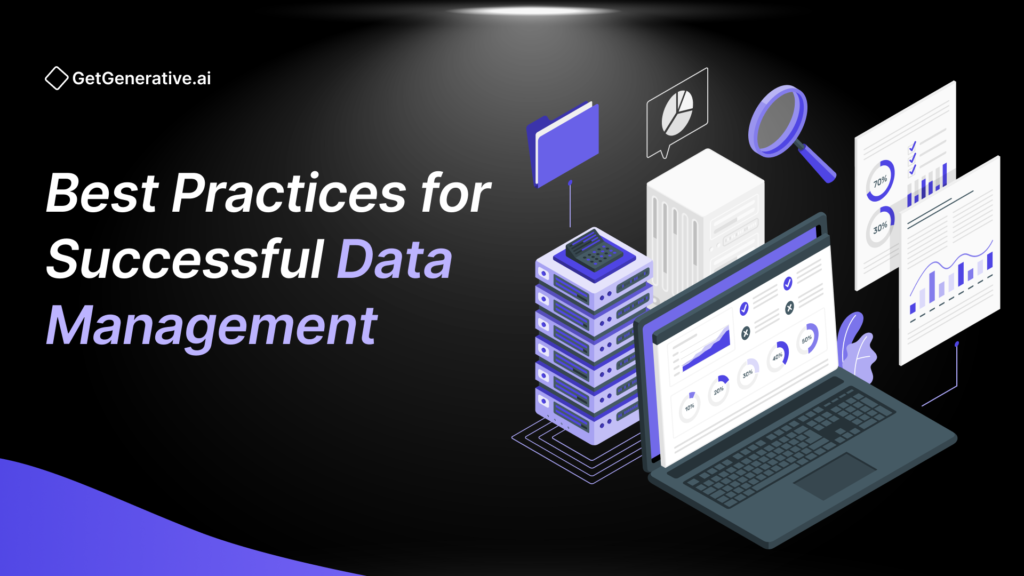Best Practices for Successful Data Management
Efficient data management has shifted from being a luxury to an absolute necessity in today’s data-driven business environment. With data serving as the cornerstone for informed decisions, businesses must implement comprehensive strategies to stay ahead. This guide delves into proven practices to ensure your data management is effective, secure, and prepared for future challenges.
What Is Data Management?
Data management encompasses the systematic processes of gathering, organizing, storing, and safeguarding data to maintain its accuracy, availability, and security. It functions as the foundation upon which successful businesses are built, enabling seamless operations and well-informed strategies.
Informed decision-making, enhanced customer experiences, and streamlined processes all stem from efficient data handling. Conversely, inadequate data management can lead to missed opportunities, compliance violations, and eroded trust. By adopting strategic practices, organizations can unlock the full potential of their data in a sustainable manner.
1. Define Clear Data Management Goals
A successful data management strategy starts with clearly defined objectives. Whether your goal is to improve customer segmentation or ensure regulatory compliance, having a roadmap helps align resources and measure success.
- Strategic Alignment: Tie data goals to broader business objectives, such as enhancing customer satisfaction or optimizing operations.
- Resource Allocation: Allocate the right tools, personnel, and budget to achieve these goals.
- Measurement and Accountability: Establish KPIs to track progress and foster accountability across teams.
2. Build Strong File Naming and Cataloging Conventions
Efficient file organization is the cornerstone of accessible data. Adopt standardized naming conventions and cataloging methods to make data retrieval intuitive.
- Use formats like YYYY-MM-DD for dates.
- Include metadata such as data author, creation date, and purpose.
- Maintain consistency across all storage systems to simplify searches.
3. Establish Robust Data Governance Policies
Establishing robust data governance is critical for outlining how information is collected, stored, and accessed within an organization.
- Clearly Define Roles and Responsibilities: Assign specific duties to data stewards, owners, and custodians to ensure accountability throughout the data lifecycle.
- Conduct Routine Security Assessments: Regular audits are essential for detecting and addressing potential vulnerabilities.
- Ensure Regulatory Compliance: Adhering to data protection laws like GDPR and CCPA fosters trust among stakeholders and minimizes legal risks.
4. Ensure Data Security and Privacy
In today’s high-risk digital environment, data security is paramount. Implement strong measures to protect sensitive information and ensure compliance with regulations.
- Encryption and Access Controls: Secure data with robust encryption and role-based access.
- Regular Security Audits: Conduct periodic assessments to identify vulnerabilities.
- Compliance: Adhere to laws like GDPR and CCPA to build trust and avoid penalties.
5. Invest in Scalable and Flexible Data Architecture
A scalable data architecture empowers organizations to respond to evolving requirements and handle increasing data volumes efficiently. This adaptability ensures businesses remain agile in the face of growth or technological advancements.
- Leverage modern storage solutions like cloud-based data lakes.
- Use APIs and microservices to enable seamless integrations.
- Incorporate metadata management for better data quality.
Also Read – Top Project Management Tools That Integrate Seamlessly with Salesforce
6. Implement the 3-2-1 Backup Strategy
Data loss can be catastrophic, making backups essential. The 3-2-1 method ensures reliability:
- 3 Copies: Maintain three copies of your data.
- 2 Storage Types: Use two different storage formats.
- 1 Offsite Location: Store one copy in a secure, remote location.
7. Commit to a Data-Driven Culture
Promote a culture where data is integral to decision-making.
- Training: Offer ongoing education to improve data literacy.
- Collaboration: Encourage cross-functional teams to share and utilize data insights.
8. Focus on Data Quality Standards
High-quality data ensures that insights are accurate and actionable. Adopt metrics to measure accuracy, relevance, completeness, and consistency.
- Establish validation and cleansing processes to rectify errors.
- Use quality checks to ensure data aligns with its intended purpose.
9. Centralize Your Data Repository
A centralized data repository improves accessibility and maintains data integrity. Implement a Single Source of Truth (SSOT) to eliminate redundancies and ensure consistency.
10. Enhance Decision-Making with Predictive Analytics
Leverage data analytics tools to gain actionable insights. Predictive models enable businesses to forecast trends, anticipate challenges, and seize opportunities.
11. Perform Regular Audits and Compliance Checks
Regular audits help identify weaknesses in your data management processes. Stay updated on regulatory changes and refine your strategy accordingly to mitigate risks.
Also Read – Guidelines for Ethical and Responsible AI Development
12. Facilitate Controlled Access to Data
Restricting access based on individual roles and responsibilities is key to protecting sensitive information. Implementing identity and access management (IAM) systems can help ensure data is only accessible to authorized personnel while maintaining operational efficiency.
13. Design Flexible Documentation Processes
Comprehensive documentation ensures data is easy to understand and use. Include details on:
- Project Context: Why the data was created.
- Tools Used: Software versions and methodologies.
- Metadata: Source, structure, and purpose of data.
14. Continuously Monitor and Improve
Data management isn’t a one-time task. Regularly evaluate your processes, solicit feedback, and adapt to evolving needs.
15. Invest in Quality Data Management Software
The right tools streamline data governance, enhance analytics, and build trust. Platforms like Tableau offer robust solutions to manage and utilize data effectively.
Conclusion
Data management is not a one-time project but an ongoing commitment. It requires a proactive approach, a willingness to adapt, and the deployment of the right strategies. By incorporating these best practices, your business can fully harness its data’s value while ensuring its accuracy, security, and reliability.
To learn more, visit GetGenerative.ai.
FAQs
1. How does the 3-2-1 backup strategy work?
It involves keeping three copies of data, using two storage formats, and storing one copy offsite for enhanced reliability.
2. What is metadata, and why is it important?
Metadata provides context about data, including its origin, structure, and purpose, aiding in efficient data discovery and usage.
3. How can businesses ensure data quality?
By establishing validation processes, adopting data quality metrics, and continuously monitoring for errors and inconsistencies.




